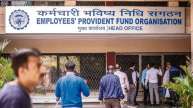New Delhi: Following the Reserve Bank of India’s (RBI) 50 basis point (bps) hike in the repo rate on September 30, retail consumers are starting to feel the heat of increased equivalent monthly instalments (EMIs).
Many lenders increased their external benchmark lending rates (EBLR) in response to the RBI’s rate increase, including the State Bank of India (SBI), Bank of India (BoI), and HDFC. The rate at which the RBI loans money to banks is known as the repo rate, and it is now 5.90 percent. Given the likelihood that bank lending rates would increase further in the upcoming months, as per a report by Moneycontrol.
“Banks have different benchmark linked lending rates including repo, government securities, base rate, and the MCLR (marginal cost of fund-based lending rate). The banks’ lending rates are hiked considering changes in the underlying benchmark. The lending rates rise on a staggered basis and reflect the cost of funds,” said Aditya Acharekar, Associate Director credit rating firm CareEdge, .
The chances of another increase in the repo rate in FY23, according to Acharekar, increased as a result of the RBI leaving its accommodative stance and shifting its attention to controlling inflation against a background of global events. Due to banks’ desire to pass on the increase as much as possible in order to preserve their margins, lending rates are therefore likely to increase further.
The largest lender in the nation, SBI, increased both its EBLR and repo-linked lending rate (RLLR) by 50 basis points each following the rate increase in September, bringing them to 8.55 percent and 8.15 percent, respectively. The RLLR of state-owned BoI was likewise increased to 8.75 percent. Following the 50 bps rate increase, peers in the private sector like ICICI Bank raised the EBLR. In addition to banks, mortgage lender HDFC raised its loan rate by 50 basis points as of October 1.
When lenders modify their lending and deposit rates in response to rate actions taken by the central bank, rate cues from the RBI are sent throughout the banking system. For example, if the RBI increases the repo rate, banks will have to borrow short-term cash from the RBI at a greater cost. Through an increase in lending rates, this additional expense is transferred to the consumer. Thus, the need for money is reduced.
To combat inflationary pressures in the economy, the Monetary Policy Committee (MPC) of the RBI has raised rates by 190 basis points (bps) since May. At its upcoming policy meeting in December, the MPC is anticipated to increase the repo rate even higher.
“At a portfolio level, lending rates will continue to inch up since EBLR-linked loans transmit rate movements faster,” said Jindal Haria, director at India Ratings. “MCLR takes time and is often more dependent on deposit rates, which too would go up in a staggered manner through the rest of the year.”













